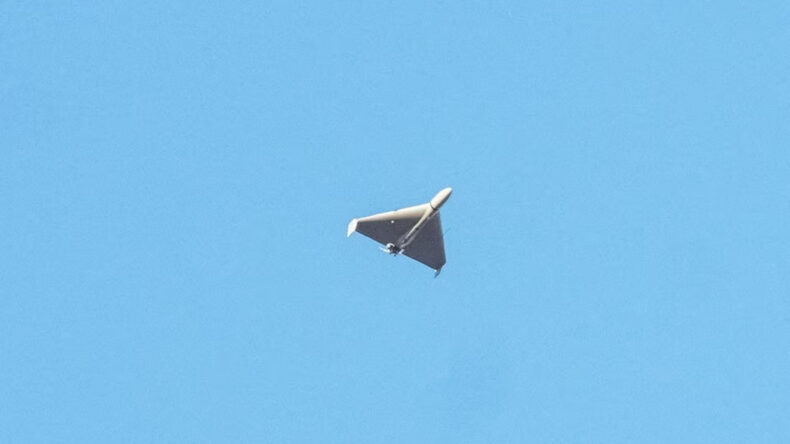In a concealed location beneath the streets of Kyiv, a significant meeting took place last month, bringing together numerous engineers and innovators along with senior military officials. Their objective was to collaboratively generate ideas for effectively countering the inexpensive Russian suicide drones that continue to cause immense destruction in Ukrainian cities.

This clandestine gathering offered a rare opportunity to witness Ukraine’s ongoing technological arms race with Russia. The country’s approach leverages innovation from the private sector, supported by state venture capital, resulting in the production of a large number of combat drones within a thriving wartime industry.
According to Mykhailo Fedorov, Ukraine’s Deputy Prime Minister and Minister for Digital Transformations, the present conflict is primarily a technological one, characterized by constant advancements in technology and battlefield strategies.
According to official data, Russia launched a record-breaking number of over 300 drones in an attack on Ukraine in May. This poses a significant challenge for planners who are concerned about safeguarding energy supplies during the upcoming winter. In the previous winter, Russia attempted to disrupt the power grid through air strikes.
Deputy Prime Minister Oleksandr Kubrakov expressed the need to prepare for the forthcoming winter and effectively address these challenges. The Iranian drones pose a particular threat as they fly at low altitudes, evading detection by air defense systems. Moreover, their navigation systems are resilient, making it difficult to neutralize them using anti-drone electronic warfare weapons that typically disrupt radio frequencies.
While the West has provided advanced air defense systems to counter missile attacks, officials highlight the impracticality of using expensive million-dollar missiles to shoot down swarms of drones that cost significantly less, around $50,000 each.
To address this, Mykhailo Fedorov emphasized the importance of reducing the cost of tools employed to combat the Iranian Shahed drones. The focus lies on enhancing detection capabilities using various methods, including acoustic sensors, and developing effective means for their destruction.
During the gathering, the participants were cautious about revealing their full names for security reasons. One of the attendees, identified as Oleksandr, shared details about their team’s innovative “quadrocopter” design, which combines wings and propellers. This hybrid drone is capable of achieving greater speed and endurance compared to existing models, enabling it to intercept, shoot down, or jam other drones effectively.
Another participant, Yuriy, an engineer and deputy head of a Ukrainian company, presented plans for new anti-drone electronic warfare systems that offer enhanced effectiveness against the Shahed drones.
Russia and Ukraine, War of Drones
According to officials, while drones have been utilized in conflicts in Yemen, Syria, and Nagorno-Karabakh, their usage has never been as extensive as in Ukraine. This unprecedented drone-centric warfare has driven significant advancements in Ukraine’s military technology innovation since Russia’s invasion.
Last year, Ukraine initiated a crowdfunding project called the “Army of Drones,” which has now evolved into a state program encompassing various aspects such as the production of unmanned aerial vehicles (UAVs) and the training of drone pilots.
Brigadier General Yurii Shchyhol, responsible for procurement within the state program, explained that shortly after the invasion began, it became evident that unmanned aerial vehicles were the most effective means for reconnaissance and defeating the enemy.
Under the state program, Ukraine has acquired 15,000 drones to date, sourced from the program itself, the Defense Ministry, foreign assistance, and volunteers. The exact total number of drones deployed by Ukraine in combat remains unknown.
Brigadier General Yurii Shchyhol stated that the objective for this year is to acquire over 200,000 large reconnaissance and strike drones, aiming to purchase as many drones as possible from the available market. Despite the risk of Russian airstrikes, drone production is now widespread across Ukraine. Manufacturers have been instructed to distribute their work among different sites and utilize bomb shelters during certain stages of the production process.
Mykhailo Fedorov noted that this approach has been effective, allowing drone production to continue without major disruption from missile strikes. Although strikes do occur, they are not on a significant scale. Fedorov emphasized that over 80% of the procured drones are made in Ukraine and assembled within the country.
Anatoliy Khrapchynskyi, an employee at a company specializing in electronic warfare technology, highlighted the contrasting approaches to technological innovation between Ukraine and Russia. He explained that while Russia’s approach is centralized and led by state organizations, Ukraine’s innovation is driven by the private sector, involving numerous smaller-sized companies.
When the project began last year, there were only seven companies capable of selling drones to the state. However, this number has now grown to 40, with an expected increase to 50 by the end of the year, according to Fedorov. He mentioned that state venture capital is facilitating the expansion of domestic production and emphasized that Ukraine holds an advantage over Russia as it can freely share technology with foreign partners without concerns about sanctions.
Fedorov further explained that state funding has led to companies starting to localize production. Although parts are currently sourced from various countries, including China, the process of localizing production is gradually progressing.













